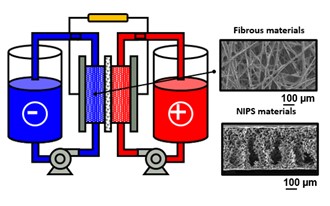Redox flow batteries (RFBs) are an emerging technological option for large-scale and multi-hour electrochemical energy storage due to their ability to decouple energy and power. Despite their intrinsic advantages, their current elevated costs hinder commercialization. Optimizing the porous electrode microstructure and surface chemistry offers a promising pathway to increase the performance of RFBs.
Non-solvent induced phase separation (NIPS) is proposed as a versatile method to synthesize porous structures suitable for RFBs with unique properties, which are unattainable in current fibrous materials. The combination of large finger-like voids and finer porosity is highly beneficial as it reduces convective transport and kinetic losses. In this research we aim to scale-up the phase separated electrodes while retaining the same microstructure, surface properties and bimodal pore size distribution of the small-scale samples, since they determine the electrochemical and transport performance. Morphological characterization and in-situ experiments in flow batteries will be performed to demonstrate the reproducibility and potential of phase-separated materials.


Contact details:
Simona Buzzi
SMP-EMS
Helix, STO 1.49
s.buzzi@tue.nl